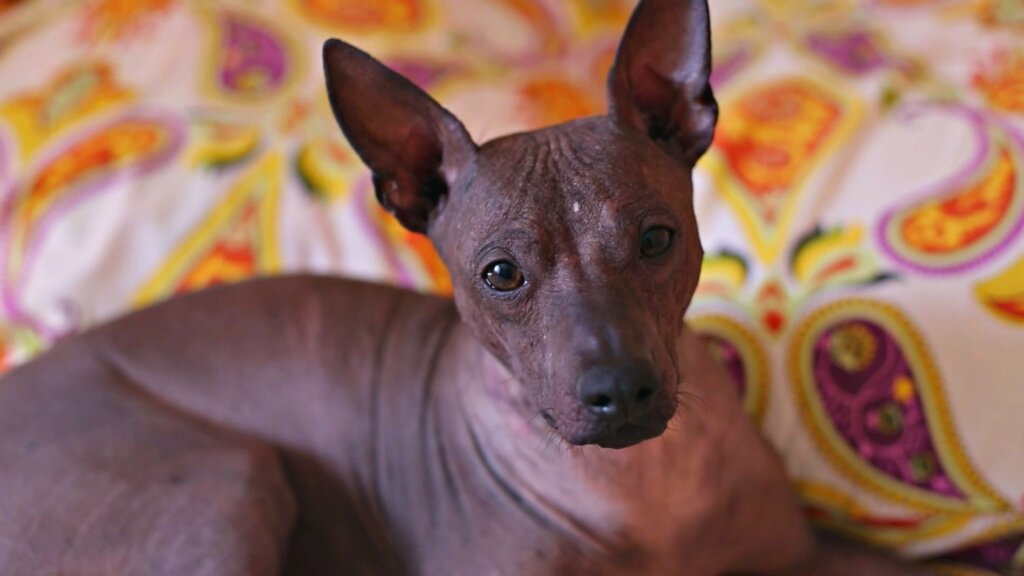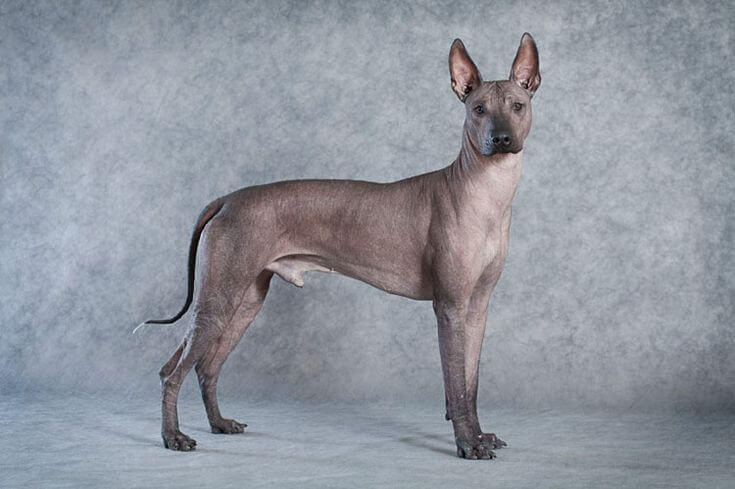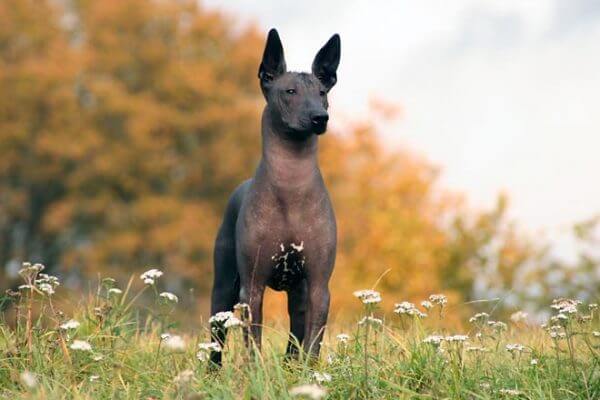All About the Xoloitzcuintli (Mexican Hairless) Dog

Undoubtedly, this dog’s appearance is one that sticks in your memory: hairless, pointed ears and a well-cut face, almost out of a hieroglyphic. We’re talking about the Xoloitzcuintli, often called the Mexican hairless dog, a dog of Aztec origin and a lot to tell.
In these lines, you’ll learn more about this peculiar breed, as well as its origins and the care needs. Don’t miss anything and, above all, don’t judge them by their peculiar appearance, because they can be a great companion for any human. Let’s begin.
Characteristics and appearance
Not everyone considers the Xoloitzcuintli an attractive dog, as it has a wrinkled forehead, slanted eyes, large, pointed ears and a thin, rat-like tail. However, the most striking characteristic of these dogs is their lack of hair or, depending on the specimen, its presence in specific areas of the body, such as the head.
It’s a breed of varying several sizes: standard (46-60 centimeters, 1.5 to 2 feet), medium (36-45 centimeters, 1.2 to 1.5 feet) and miniature (25-35 centimeters, 0.8 to 1.15 feet).
These dogs are longer than they are tall and have no (or very little) hair. Their skin can be dark or light brown and mottled with black, gray, reddish, brown or tan. In fact, because of this characteristic, they’re considered to be dogs suitable for people with mild allergies to dog epithelium.

Origin of the breed
The first records of the Xoloitzcuintli are from Mexico. While its true origins are considered a mystery, images of hairless dogs quite similar to this breed have been found in several Aztec ruins. Hypotheses to the contrary claim that these are mammals similar to the Xoloitzcuintli and bred without hair for food.
It’s thought that the ancestors of this dog were the dogs that accompanied migratory peoples across the Bering mass.
Even so, the meat of the Xoloitzcuintli was consumed, as it was considered a sacred animal and its meat was used in ritual ceremonies. This dog takes its name from the Aztec deity Xolotl, the god of fire and escort of the dead to the underworld, and “itzcuintli”, the Aztec word for dog. Healing powers and protection against evil spirits were attributed to them.
Today, after being in danger of extinction, this breed has recovered and is considered a national treasure of Mexico. There are approximately 30,000 specimens worldwide.
Temperament of the Xoloitzcuintli
They’re calm and aloof with strangers. They tend to choose one person as their “favorite” and, although they also care for and show affection towards other members of the family, they usually stay close to their chosen companion.
They have a great guarding instinct, so they require special attention in this aspect of their training so that they don’t become overprotective or aggressive towards strangers. They’re sensitive dogs with a marked personality, so it’s advisable to adopt them when you already have experience with dogs.
Their activity level is medium, as they enjoy a long walk and some exercise, but at home they’ll spend most of the time resting. As puppies, however, they’re much more active and have a tendency to destroy objects, so they require a lot of time from their owners.
General health
The Xoloitzcuintli is in good general health and isn’t prone to serious congenital diseases, as far as we currently know. However, they still need their vaccination and deworming schedule up to date, so don’t neglect that aspect as well as regular check-ups.
Their weakest aspect, as you can imagine, is their fur, which is non-existent. This makes them quite prone to sunburn and skin wounds. It also makes thermoregulation difficult, so they’ll be colder in winter and hotter in summer.
Another frequent problem that the Xoloitzcuintli suffer from is their teeth, since many of them don’t have premolars. Although this doesn’t affect their ability to eat, it’s important to check their mouths often to avoid problems related to tartar and gingivitis.
Specific care of the Xoloitzcuintli or Mexican Hairless

It’s very important to keep their nails well trimmed, as they grow quickly. The teeth also require special attention and you should brush them at least 3 times a week.
Of course, the skin is also an aspect to check frequently. Protect them from the sun with specific creams for dogs and keep them warm in winter. If there’s any wound, bruise, crack in the skin or any type of burns, go to the vet.
And finally, remember that this is a breed that should be given consistent, dedicated and positive training. Otherwise, socialization with other members of the family (human or not) and with strangers could become very complicated. Before adopting a Mexican hairless, consider very seriously if you’re going to be able to give it a dignified life.
All cited sources were thoroughly reviewed by our team to ensure their quality, reliability, currency, and validity. The bibliography of this article was considered reliable and of academic or scientific accuracy.
- Garza, M. D. L. (2014). El carácter sagrado del xoloitzcuintli entre los nahuas y los mayas. Arqueología mexicana, 21(125), 58-63.
- Clark, R. D. (2015). Medical, Genetic & Behavioral Risk Factors of Xoloitzcuintli. Xlibris Corporation.
- Wilkosz, I. (2019). Aztec Dogs: Myths and Ritual Practice. In Animals and their Relation to Gods, Humans and Things in the Ancient World (pp. 367-387). Springer VS, Wiesbaden.
- XOLOITZCUINTLE. (s. f.). FCI. Recuperado 7 de junio de 2022, de http://www.fci.be/es/nomenclature/XOLOITZCUINTLE-234.html